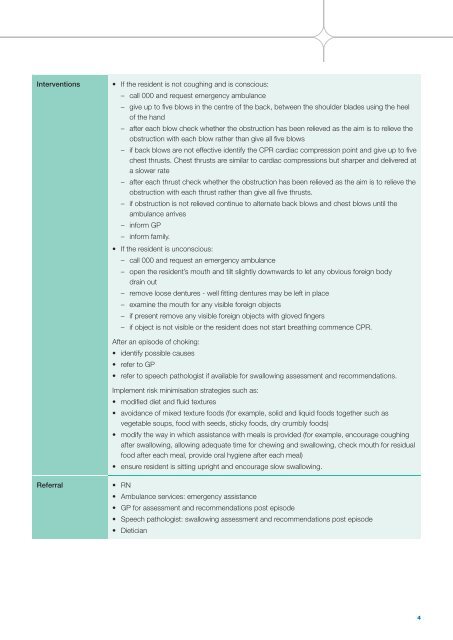Standardised care process - choking (138kb, pdf) - Department of ...
Standardised care process - choking (138kb, pdf) - Department of ...
Standardised care process - choking (138kb, pdf) - Department of ...
You also want an ePaper? Increase the reach of your titles
YUMPU automatically turns print PDFs into web optimized ePapers that Google loves.
Interventions<br />
• If the resident is not coughing and is conscious:<br />
– call 000 and request emergency ambulance<br />
– give up to fi ve blows in the centre <strong>of</strong> the back, between the shoulder blades using the heel<br />
<strong>of</strong> the hand<br />
– after each blow check whether the obstruction has been relieved as the aim is to relieve the<br />
obstruction with each blow rather than give all fi ve blows<br />
– if back blows are not effective identify the CPR cardiac compression point and give up to fi ve<br />
chest thrusts. Chest thrusts are similar to cardiac compressions but sharper and delivered at<br />
a slower rate<br />
– after each thrust check whether the obstruction has been relieved as the aim is to relieve the<br />
obstruction with each thrust rather than give all fi ve thrusts.<br />
– if obstruction is not relieved continue to alternate back blows and chest blows until the<br />
ambulance arrives<br />
– inform GP<br />
– inform family.<br />
• If the resident is unconscious:<br />
– call 000 and request an emergency ambulance<br />
– open the resident’s mouth and tilt slightly downwards to let any obvious foreign body<br />
drain out<br />
– remove loose dentures - well fi tting dentures may be left in place<br />
– examine the mouth for any visible foreign objects<br />
– if present remove any visible foreign objects with gloved fi ngers<br />
– if object is not visible or the resident does not start breathing commence CPR.<br />
After an episode <strong>of</strong> <strong>choking</strong>:<br />
• identify possible causes<br />
• refer to GP<br />
• refer to speech pathologist if available for swallowing assessment and recommendations.<br />
Implement risk minimisation strategies such as:<br />
• modifi ed diet and fl uid textures<br />
• avoidance <strong>of</strong> mixed texture foods (for example, solid and liquid foods together such as<br />
vegetable soups, food with seeds, sticky foods, dry crumbly foods)<br />
• modify the way in which assistance with meals is provided (for example, encourage coughing<br />
after swallowing, allowing adequate time for chewing and swallowing, check mouth for residual<br />
food after each meal, provide oral hygiene after each meal)<br />
• ensure resident is sitting upright and encourage slow swallowing.<br />
Referral<br />
• RN<br />
• Ambulance services: emergency assistance<br />
• GP for assessment and recommendations post episode<br />
• Speech pathologist: swallowing assessment and recommendations post episode<br />
• Dietician<br />
4
















